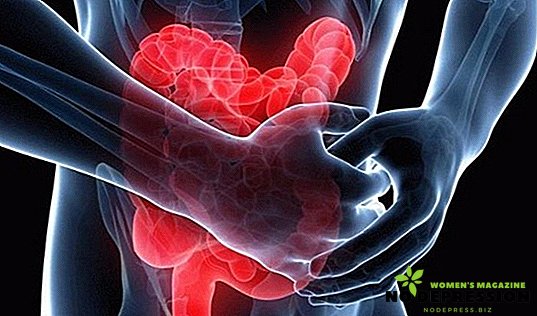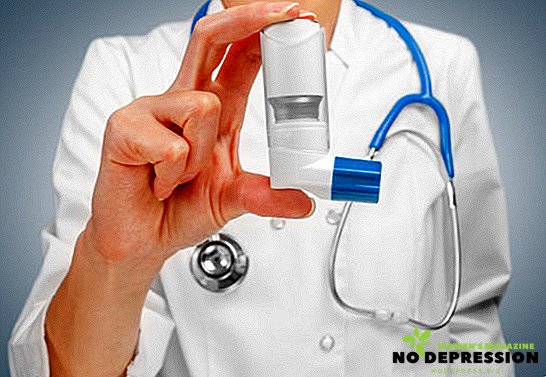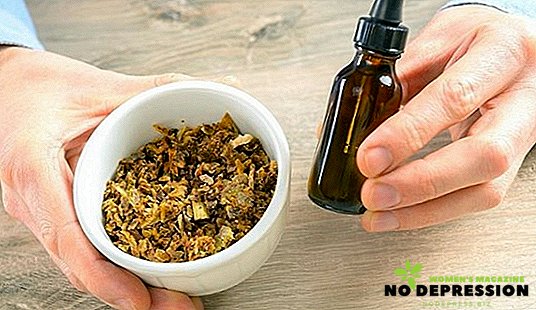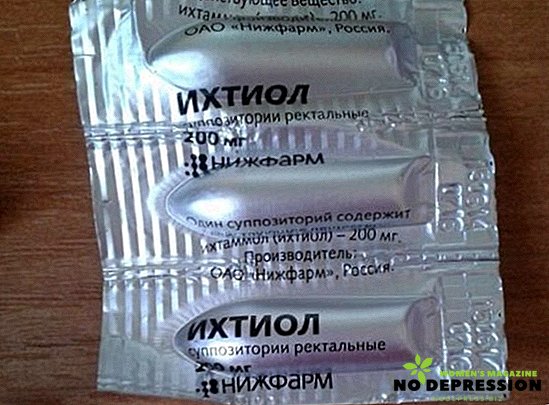Ulcerative colitis (the old name is “ulcerative colitis”) is a chronic inflammatory disease of the large intestine. This disease is widespread in Europe, North America and Australia - 10-15 people per 100 thousand people get it here every year. Most often it affects people of young and mature age.

How ulcerative colitis manifests itself
All symptoms of the disease can be divided into local (associated directly with the defeat of the intestine) and common (due to disruption of the various body systems).
Local signs
- lower abdominal pain, usually on the left side;
- nausea not associated with eating;
- tenesmus (painful forced urge to defecate);
- frequent mushy stools, often with admixture of blood, mucus or pus.
Common symptoms
 fever;
fever;- weight loss (characteristic primarily for the chronic course of the disease);
- convulsions, interruptions in the work of the heart, night sweats (associated with a violation of the content of water and electrolytes);
- pyoderma (pustular skin lesions);
- appearance of nodular rash on the trunk and extremities;
- joint pains not related to physical exertion
- aphthous stomatitis (the appearance of painful ulcers on the mucous membrane of the oral cavity);
- jaundice combined with a feeling of heaviness in the right side.
It should be noted that all common signs, with the exception of fever, are optional and may be completely absent.
Causes of ulcerative colitis
 A single look at the etiology of this disease still does not exist. Among the possible culprits are genetic factors (the presence of close relatives of Crohn's disease, familial polyposis of the colon, asthma, psoriasis and a number of other diseases), the effects of various infectious agents (Epstein-Barr viruses, cytomegalovirus, pathogenic strains of E. coli, Shigella), and also some medicinal substances and food products (hormonal contraceptives, corticosteroids, as well as fried foods, brandy and tobacco smoke products).
A single look at the etiology of this disease still does not exist. Among the possible culprits are genetic factors (the presence of close relatives of Crohn's disease, familial polyposis of the colon, asthma, psoriasis and a number of other diseases), the effects of various infectious agents (Epstein-Barr viruses, cytomegalovirus, pathogenic strains of E. coli, Shigella), and also some medicinal substances and food products (hormonal contraceptives, corticosteroids, as well as fried foods, brandy and tobacco smoke products).
A number of researchers have shown the relationship of ulcerative colitis with inflammatory diseases of the large intestine, primarily microbial and amoebic dysentery. In addition, this disease often occurs in people with any autoimmune pathology: rheumatoid arthritis, scleroderma, celiac disease.
Diagnosis of ulcerative colitis
The diagnosis in the case of ulcerative colitis is made on the basis of clinical data, anamnesis, laboratory and instrumental methods only after a biopsy and histological examination of the material.
Laboratory research methods
General blood analysis
 With this disease, anemia will occur (decrease in hemoglobin concentration and red blood cell count), as well as signs of inflammation (increased white blood cell count and ESR).
With this disease, anemia will occur (decrease in hemoglobin concentration and red blood cell count), as well as signs of inflammation (increased white blood cell count and ESR).
Blood chemistry
Ulcerative colitis is characterized by an increase in the iron-binding capacity of blood plasma (the body mobilizes iron reserves to restore hemoglobin), as well as the appearance of inflammatory "acute phase proteins": C-reactive protein, ceruloplasmin, and gamma fractions of globulins.
Determining the level of fecal calprotectin
This protein is contained within neutrophils - one of the key participants in the body's immune defense. The increased content of this marker in the feces indicates inflammation in the intestinal wall, but by itself it cannot unambiguously testify in favor of ulcerative colitis.
Bacteriological seeding feces
This study aims to eliminate the infectious nature of the inflammatory process.
Instrumental research methods
Ray research methods
 Radiography and computed tomography in ulcerative colitis are not informative and rather serve to exclude another pathology with similar clinical and laboratory manifestations: intestinal tumors, fibrous adhesions with partial intestinal obstruction;
Radiography and computed tomography in ulcerative colitis are not informative and rather serve to exclude another pathology with similar clinical and laboratory manifestations: intestinal tumors, fibrous adhesions with partial intestinal obstruction;
Fibrocolonoscopy
Colonoscopy (insertion of a flexible conductor with a manipulator and a camera through the rectum) with biopsy taking is the “gold standard” for diagnosing this disease. Moreover, ulcerative colitis is characterized by the presence of a large number of bright red erosions in combination with finger-like outgrowths of the intestinal mucosa in the acute stage of the process or dull granulation tissue during remission.
Histological examination
Obtained during colonoscopy, fragments of the intestinal wall are subject to histological examination by a pathologist. For ulcerative colitis is characterized by the presence of erosions, ulcers with fibrinoid necrosis of the walls of nearby vessels.
Another morphological sign of the disease is the presence of polyps and pseudopolyps. The former are an overgrowth of the intestinal mucosa in response to chronic inflammation, and the latter are the overhang of preserved fragments of the mucosa over the ulcer defect.
In addition, the presence of crypt abscesses, small foci of purulent inflammation located in the recesses of the intestinal wall, is characteristic of ulcerative colitis.
Of particular difficulty is the differential diagnosis of ulcerative colitis and regional enteritis (Crohn's disease). Both pathologies can damage the colon and have a similar clinical picture. Differences between them are revealed during colonoscopy (for ulcerative colitis, the presence of irregularly shaped irregular wall defects is characteristic, and for Crohn's disease, the picture of cobblestone: an alternation of depressive and ascending portions).
The final distinction between the two diseases is also carried out in the post-mortem examination of biopsy specimens. In regional enteritis, ulcerative defects almost always capture the muscular layer of the intestine, and between them nonspecific granulomas that are similar in structure to the granulomas in sarcoidosis are detected.
Ulcerative Colitis Treatment
Diet
During the exacerbation of ulcerative colitis, the patient is prescribed a table 4a, in addition, all products to which an allergic reaction is possible are excluded. Among scientists there are supporters of anti-inflammatory diet, which consists in limiting the use of carbohydrates, animal fats and large proteins. However, studies proving the effectiveness of such a diet are not available.
Drug therapy
5-aminosalicylic acid derivatives
 Sulfasalazine and mesalazine are first-line drugs in the treatment of ulcerative colitis. When they enter the intestine under the action of local microflora, they are split into sulfopyridine and aminosalicylic acid. Aminosalicylic acid has an anti-inflammatory effect, and sulfopyridine serves to accelerate the healing of the ulcer.
Sulfasalazine and mesalazine are first-line drugs in the treatment of ulcerative colitis. When they enter the intestine under the action of local microflora, they are split into sulfopyridine and aminosalicylic acid. Aminosalicylic acid has an anti-inflammatory effect, and sulfopyridine serves to accelerate the healing of the ulcer.
If the lesion is limited only to the rectum, the use of sulfasalazine in the form of suppositories or microclyster is shown.
However, these drugs have a large number of side effects, including neuropsychiatric disorders, folic-deficiency anemia, astheno-vegetative syndrome.
Immunosuppressants
For the treatment of ulcerative colitis is widely used drug Tofacitinib. This substance blocks the transmission of signals in immune cells responsible for the onset of the inflammatory response. Numerous international randomized studies demonstrate persistent remission in patients taking a course of tofacitinib.
Hormonal drugs
Steroid hormones, primarily prednisone and dexamethasone, are also used to suppress the inflammatory response. Their dosage is similar to that of rheumatic diseases and can reach (for prednisone) 240 mg per day. It should be noted that the long-term administration of these drugs is not shown, their main purpose is to suppress the pronounced attack during the onset of exacerbation of ulcerative colitis. The maintenance of remission with their constant admission does not occur.
Antibody Recombinant Preparations
 Infliximab is a monoclonal antibody that binds to a substance called tumor necrosis factor - alpha (TNF). This substance is actively involved in attracting immune cells to the focus of inflammation, respectively, its shutdown inhibits the activity of colitis.
Infliximab is a monoclonal antibody that binds to a substance called tumor necrosis factor - alpha (TNF). This substance is actively involved in attracting immune cells to the focus of inflammation, respectively, its shutdown inhibits the activity of colitis.
Vedolizumab is also a monoclonal antibody, but its target is integrin receptors. These receptors are normally involved in the life of almost any cell, but during the inflammatory reaction, they are the ones that cause the entry of new leukocytes into the lesion.
Surgery
Surgical treatment of ulcerative colitis is rarely carried out and only in the event of the development of serious complications, such as intestinal cancer, perforation of the ulcerative defect or bleeding. The most commonly performed removal is a fragment of a direct, sigmoid and descending colon - the so-called left-sided hemicolectomy.
Treatment of ulcerative colitis folk remedies
A recognized drug for ulcerative colitis is ginseng root. The extract of this plant has an anti-inflammatory and immunomodulatory effect, which contributes to the attenuation of the inflammatory process in the colon.
Curcumin (part of the curry), which is able to accelerate the healing of ulcers, and bromelain (an enzyme contained in pineapples), which is attributed to the ability to suppress inflammation, have also proven themselves well.
Prevention of ulcerative colitis
 The main methods of prevention are to avoid inflammatory diseases of the colon of an infectious nature. In addition, a number of researchers are considering the removal of the appendix as one of the possible methods of preventing ulcerative colitis. Elimination of a local immune organ reduces the likelihood of an immuno-inflammatory reaction.
The main methods of prevention are to avoid inflammatory diseases of the colon of an infectious nature. In addition, a number of researchers are considering the removal of the appendix as one of the possible methods of preventing ulcerative colitis. Elimination of a local immune organ reduces the likelihood of an immuno-inflammatory reaction.
There is evidence that the incidence of ulcerative colitis is significantly increased in people who quit smoking. In this regard, for the prevention of the disease, it is necessary to use nicotine patches, and not completely abandon nicotine.
Feedback
I was diagnosed with ulcerative colitis four years ago. At first I tried to be treated with mesalazine on the recommendation of doctors. The effect was not observed. He lost weight, began to feel constant weakness. Then he decided to try Enivio. Expensive drug, but almost all the symptoms disappeared. Gained 6 kg, drank a course of iron and weakness disappeared.
Nikolay Bessstuzhev, 44 years old


 fever;
fever; Of particular difficulty is the differential diagnosis of ulcerative colitis and regional enteritis (Crohn's disease). Both pathologies can damage the colon and have a similar clinical picture. Differences between them are revealed during colonoscopy (for ulcerative colitis, the presence of irregularly shaped irregular wall defects is characteristic, and for Crohn's disease, the picture of cobblestone: an alternation of depressive and ascending portions).
Of particular difficulty is the differential diagnosis of ulcerative colitis and regional enteritis (Crohn's disease). Both pathologies can damage the colon and have a similar clinical picture. Differences between them are revealed during colonoscopy (for ulcerative colitis, the presence of irregularly shaped irregular wall defects is characteristic, and for Crohn's disease, the picture of cobblestone: an alternation of depressive and ascending portions).









